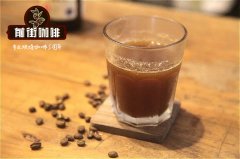Caramelization (caramelization, oxidation and browning of sugars) during coffee roasting

Professional coffee knowledge exchange more coffee bean information please follow the coffee workshop (Wechat official account cafe_style)
Qianjie Coffee shares the caramelization reaction (caramelization, oxidation and browning of sugars) during coffee roasting with Mena.
Most of the time we always say that coffee smells good, so where does the aroma of coffee come from? In fact, coffee beans themselves store a variety of raw materials, such as carbohydrates, proteins, lipids, organic acids and so on. After heating and baking, it will start a series of complex reactions, creating an attractive aroma. There are two reactions in baking that have to be mentioned.
Caramelization (caramelization, oxidation and browning of sugars) and Mena reaction (Maillard reaction, reaction of amino acids with sugars).
Both reactions require the participation of sugars, and the rich sucrose in raw beans provides the materials needed for these two reactions. Previous studies also found that there was a positive correlation between sucrose content and coffee bean flavor.
The slight change of temperature and time length in Maillard reaction will have a great influence on the final flavor of coffee.
Long-term Maillard reaction will increase the viscosity of coffee, and relatively short-term Maillard reaction will bring more sweetness and acidity to coffee beans. This is because the fruity and sweetness brought by acidity in coffee can be destroyed by Maillard reaction for too long.
Caramelization reaction
The sugar in the coffee bean is caramelized at about 170-200 ℃, which is exactly the melting point of sucrose (185 ℃) and the temperature of the explosion stage when the coffee bean is roasted. The product of caramelization is divided into two parts:
The dehydration products of sugar are caramel or sauce-colored pyrolysis products, mainly volatile aldehydes and ketones.
Generally speaking, fire-roasted aroma, caramel and color are produced in the caramelization reaction, as well as other aromatic substances such as maltol, Cyclotene, furan and so on. These compounds can also be found in red wine, fruit juices, cream and other foods.
However, if the caramel is too much in the process of baking, it will cause carbonization and make the coffee dry and choking. If the caramel is not enough, it will make the aroma monotonous and lack of layers.
But if the Maynard reaction and caramelization degree are just right in the coffee, the high-quality acid in the coffee is retained, which can best reflect the flavor of the coffee bean itself.
Important Notice :
前街咖啡 FrontStreet Coffee has moved to new addredd:
FrontStreet Coffee Address: 315,Donghua East Road,GuangZhou
Tel:020 38364473
- Prev

Coe Paradise Manor coe Paradise Manor Story coe Paradise Manor Coffee flavor description
Professional coffee knowledge exchange more coffee bean information please follow Coffee Workshop (Wechat official account cafe_style) Paradise Manor is a specialty coffee project, through certification to adapt to organic practice, to ensure the harmlessness and quality of products. Fifty years ago, this was a piece of land in the dessertic Santander area, located in Chicamocha Canyon. Now it's a 100ha forest.
- Next

The Origin of Elephant beans Coffee beans are delicious
For more information on coffee beans, please follow the coffee workshop (Wechat official account cafe_style). The most famous typica mutation in Maragogype was first found in Maragogibi, Bahia State, Brazil. Malagoji produces the world's largest coffee beans, sometimes called elephant beans (not to be confused with a defect called elephant ears). Mara.
Related
- Beginners will see the "Coffee pull flower" guide!
- What is the difference between ice blog purified milk and ordinary milk coffee?
- Why is the Philippines the largest producer of crops in Liberia?
- For coffee extraction, should the fine powder be retained?
- How does extracted espresso fill pressed powder? How much strength does it take to press the powder?
- How to make jasmine cold extract coffee? Is the jasmine + latte good?
- Will this little toy really make the coffee taste better? How does Lily Drip affect coffee extraction?
- Will the action of slapping the filter cup also affect coffee extraction?
- What's the difference between powder-to-water ratio and powder-to-liquid ratio?
- What is the Ethiopian local species? What does it have to do with Heirloom native species?

